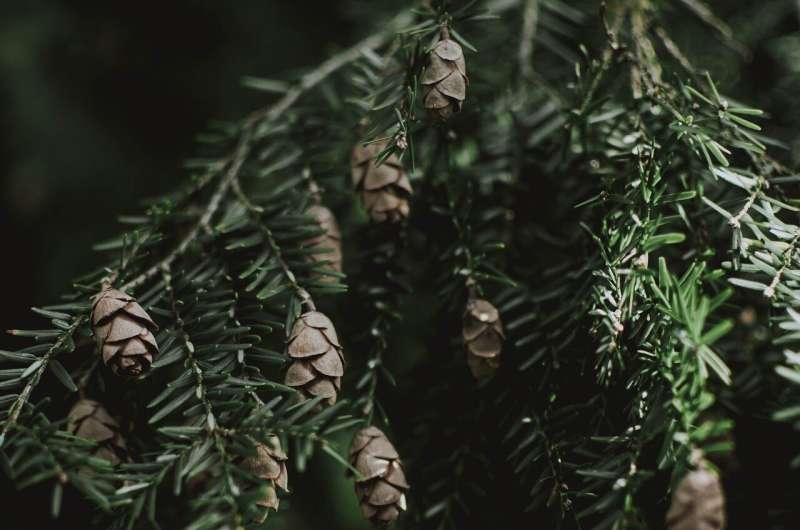This article has been reviewed according to Science X's editorial process and policies. Editors have highlighted the following attributes while ensuring the content's credibility:
fact-checked
peer-reviewed publication
trusted source
proofread
Sourcing genomically-diverse seedlings to create climate-change resilient forests brings optimism

A research paper from University of Vermont's Keller Laboratory examining the impacts of genomically-diverse seedlings on the resilience of red spruce forests in a changing climate was published in Applications in Plant Sciences.
The paper represents a multi-year, hands-on research partnership between University of Vermont (UVM), The Nature Conservancy (TNC), Central Appalachian Spruce Restoration Initiative (CASRI), Appalachian Forest Restoration, and United States Forest Service (USFS).
The research looks at how integrating knowledge of genetic variation into restoration practices may help to mitigate the threats that global anthropogenic change pose to our forest ecosystems, and develops methods of sourcing tree seeds to ensure the highest diversity and future adaptability of at-risk species.
The roots of the project formed during a CASRI conference in 2018 when experts from various organizations learned about red spruce genetic research being conducted by Keller's lab and collaborators at University of Maryland. The group saw an opportunity to join forces to take an on-the-ground approach to utilizing the genetic data for red spruce restoration. In 2019, funding enabled this group to pursue science-informed restoration at scale.
"Science-informed restoration requires intentional collaboration across restoration practice, conservation strategy, and science," says Katy Shallows, remarking on the critical importance of this collaboration.
"Folks who work in each realm need to be together at the table to work through the negotiations of what's possible and what moves the needle on improved forest management. We had a 'dream team' of collaborators who were game to take on the give-and-take to get from genetic research outcomes to collecting red spruce cones in new locations and planting in places with conservation value."
Beginning in 2019, the team analyzed genome sequencing data from 65 populations of red spruce to determine different locations where seed could be collected to generate a genetically-diverse stock for restoration. From there, researchers designed a method for monitoring the seedlings after planting so their survival and growth could be tracked and studied.
In 2021, after genetically-diverse red spruce seed sources were identified, collected, and grown up in a nursery, CASRI and TNC planted 58,000 red spruce seedlings across 255 acres in Maryland, West Virginia, and Virginia. Data on these seedlings' growth were collected and analyzed in 2022 to determine the validity of the seed source selection strategies.
The benefits of the study's strategy to seed selection based on genetic diversity are to increase the current establishment success of new trees while also boosting forests' future evolutionary potential to respond to climate change stressors.
The project was a model of stakeholder involvement across diverse sectors: governmental science funding, academic researcher expertise, non-profit conservation organizations leadership, and commercial company project execution. The study's approach of pooling multiple sources of seed in optimized combinations results in restoration stock that has higher genetic diversity and evolvability while also minimizing the load of deleterious mutations that can lead to inbreeding depression.
This approach provides new insights into how genetic data can inform tree restoration and conservation, making it more successful and, hopefully, more resource-efficient by increasing establishment success and building resiliency to future changes.
"The scientific community has made major strides in understanding species' adaptability to climate change over the past decade" says Anoob Prakash, a Ph.D. candidate in the Keller Lab at UVM and the study's lead author.
"But these efforts are not always adopted in management settings for a myriad of reasons. Our study outlines how to bridge the gap between scientific discovery and real-world applications. Hopefully, such collaborations become the norm rather than the exception."
According to Stephen Keller, "This study gives me a lot of optimism that people from different professional backgrounds, each bringing their unique expertise and passion for conservation, can come together to co-develop unique solutions to aid the future resiliency of our forests. There is tremendous potential for translating basic research findings into 'boots on the ground' conservation practices. We just need to keep finding ways to work together."
More information: Bringing genomics to the field: An integrative approach to seed sourcing for forest restoration, Applications in Plant Sciences (2024).
Journal information: Applications in Plant Sciences
Provided by University of Vermont




















